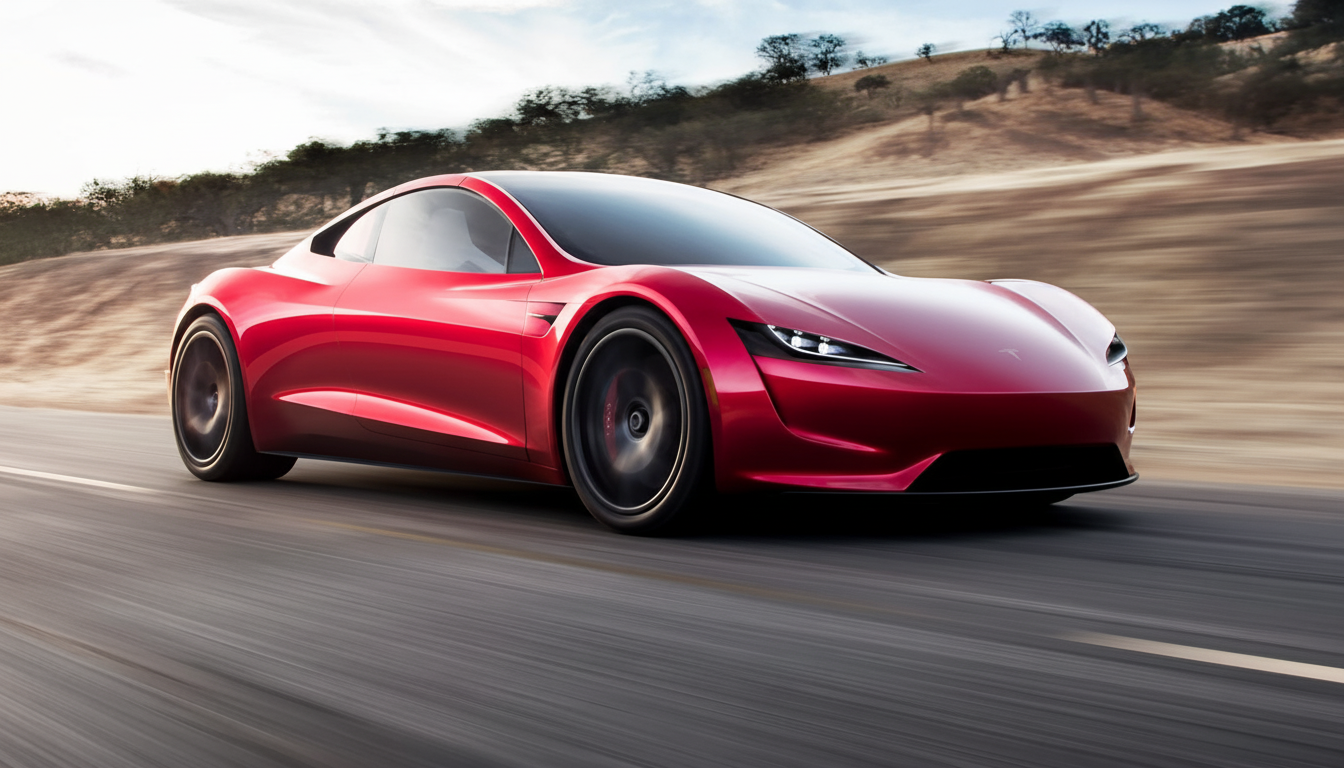Musk teases flying Tesla Roadster demo. Elon Musk says Tesla will stage a public demonstration of a “flying” Roadster, with plans to revive the long-delayed halo project featuring “crazy” technology and a reveal he argues may be truly unforgettable. The assertion, made during a two-hour appearance on The Joe Rogan Experience, rekindles the lingering question of what a sports car with lift capability could look like and whether Tesla can accomplish any additional engineering innovations following years of postponed deadlines.
What Musk suggested is that the forthcoming Roadster would reveal more than his early previews. “It’s gonna be like, you know, crazier than all the James Bond cars,” Musk replied when asked if his firm has constructed a flying car. Prior to the demonstration, he cautioned people to “just wait till you witness it yourself.”

No specifics on hard specs or production goals were provided, nor is the idea behind it out of line with the usual strategy that the project has maintained from the start. Tesla has historically utilized the Roadster as a test lab for new technology and as a beacon for marketing: this one is a supercar built in limited numbers to indicate what Tesla and its engineers could accomplish when they are given full creative freedom. This structure makes a public demonstration quite conceivable, even if deliveries to consumers are still distant.
How a ‘Flying’ Tesla Roadster Could Work in Real-World Demos
No street-legal airplane is anticipated by industry watchers. Instead, EV outlet Electrek has implied a more realistic interpretation: short-duration hops or hover-like maneuvers powered by integrated thrusters or high-output fans.
Musk has teased a “SpaceX package” in the past using cold-gas thrusters—small rocket-style nozzles driven by compressed gas—to increase acceleration while also, perhaps, creating momentary lift. For example, cold-gas thrusters are mechanically simple and can produce quick bursts of force, yet they require high-pressure tanks, plumbing, and finely controlled software. This decreases trunk space, adds weight, and introduces the issue of tanks needing to be re-pressurized between stunts.
Ducted fans are another alternative utilized in the McMurtry Spéirling, enabling similar technology to produce massive low-speed downforce and set hill-climb records. However, reversing that for lift increases noise, safety risks, and the level of debris thrown around the car and bystanders. These airborne modes will be geofenced, limited in duration, and potentially exclusive to private venues. A controlled “hop” is nontrivial in a two-ton EV, even if simple. Finally, bodywork, tires, and suspension will have to endure many events.
Leading figures from earlier Roadster previews include sub-two-second 0–60 mph acceleration claims, a supercar-type top speed, and cruising range on a big battery pack. If Tesla adds thrusters, a short “boost” would momentarily increase straight-line performance more than tire grip alone, especially across the first few meters where tire grip dominates.
The competitive bar keeps rising. The Rimac Nevera has posted independent 0–60 mph results under 1.8 seconds and set multiple acceleration and braking records. Lucid’s Air Sapphire has demonstrated quarter-mile passes in the 8-second range while retaining four doors and a full interior. To earn its halo, Roadster will need not just outrageous claims but repeatable, instrumented performance in independent tests.

Delays, deposits, and buyer patience test the Roadster timeline
The next-gen Roadster has slipped multiple times, testing the patience of early reservation holders, who made a $50,000 deposit for each standard reservation, and far more for special editions. Even some high-profile customers have publicly requested refunds, underscoring how long the wait has become.
A successful demo would help reset the narrative, but credibility now hinges on evidence rather than hype. Moreover, Tesla’s own product cadence adds pressure; the brand built its reputation by shipping difficult things at scale. A theatrically capable Roadster that remains perpetually “two quarters away” risks eroding that image, even if the underlying engineering is clever.
Regulatory and safety hurdles for any lift-capable Roadster features
Any feature that lifts a vehicle off the ground will invite regulatory scrutiny. NHTSA governs road safety, and the FAA oversees aircraft operations; whether a brief hop triggers aviation rules depends on how the system is classified and where it’s used. Tesla could sidestep the thorniest issues by limiting “flight” to demonstration modes or non-public roads. Moreover, insurers may also insist on strict guardrails, including software locks, training prompts, and location-based restrictions.
Thermal and acoustic signatures matter, too. Thrusters and fans can be loud, kick up debris, and subject bystanders to blast forces. Expect robust interlocks, perimeter sensing, and conservative software that refuses to engage unless conditions are ideal.
Why this matters for Tesla’s brand, finances, and product strategy
Tesla’s latest quarterly results reported a 37% profit decline, reflecting price cuts, strong competition, and large spending in autonomy and manufacturing. A Roadster demo that can catch people’s eyes—and unlock premium margins on a low-volume halo—can increase brand impetus in the eyes of investors who need proof of new innovation outside of incremental updates.
The flip side: overpromising can mean substantial expense. If “flying” is a remarkable but somewhat trivial stunt, Roadster must still have unparalleled performance, range, and design to be worth the wait and price. Tesla has shown the ability to turn bold ideas into shippable software and hardware. To this end, this one will need the same discipline, plus exquisite safety engineering.
The bottom line: a breathtaking demo is possible, particularly with cold-gas or fan-assisted stunts. The test is whether Tesla can turn an extravaganza into a dependable, regulatable, and marketable product. Until then, Roadster remains the corporation’s most significant pledge—and its most significant question.

